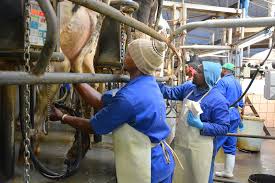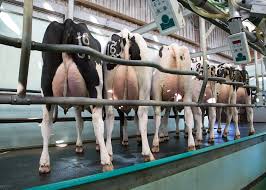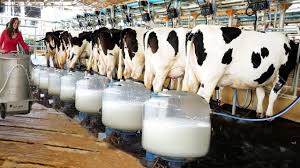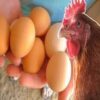In the previous article, the management of dairy cows was discussed. This article will focus on the milking process in a dairy farm.
The milking process is critical because improper milking techniques can cause injury to the udder, reduce milk yield, and potentially lead to diseases such as mastitis. Milk is an essential nutrient for humans, containing proteins, calcium, potassium, phosphorus, vitamin A, riboflavin, and thiamine.
Management of Milking Cows
Dairy cows are creatures of habit and respond well to routine procedures. Milking is generally performed twice a day early in the morning (5:30 am) and late in the afternoon (3:30 pm).
Milking more than twice a day can increase milk production, though it requires more labor. Between the two milking sessions, animals are either grazed or fed concentrates in pens, or both.
In tropical climates, it is advisable to graze animals in the mornings and evenings to avoid the high ambient temperatures during the day.
However, grazing should not occur too early in the morning to prevent bloat, which can be caused by cattle eating too much grass or dew-covered grass. Concentrate feeding is done based on the cow’s milk production.
Read Also: Bird of Paradise Flower (Strelitzia reginae): All You Need To Know About
Milking Systems

There are two primary milking methods, each with its advantages and disadvantages.
1. Hand Milking: This traditional method is labor-intensive, time-consuming, and inefficient. It can lead to injury to the milker and has a higher incidence of milk contamination, which may come from the cow, the herdsman, or environmental factors like dust and insects. However, it is inexpensive and is used with certain breeds of cattle, such as Sahiwal, which have large teats that cannot be fitted into a milking machine.
2. Machine Milking: This method is more efficient and allows for milking large numbers of cows in a shorter period. The milk obtained from machine milking is clean and free from contaminants. However, the equipment is expensive to acquire, install, and maintain. The operation and maintenance of the machines require expertise.
Milking Procedure
The milking process follows a step-by-step procedure to ensure cleanliness and prevent contamination:
- Both the milker’s hands and equipment should be cleaned and sanitized to prevent contamination by microorganisms.
- The udder and teats of the cow should be washed with warm water and a sanitizing solution and then massaged. It is advisable to use individual napkins or disposable paper towels for cleaning the udder after washing. This helps stimulate milk ejection and prevents contamination.
- If hand milking is used, vaseline should be applied to soften the teats.
- Whether hand or machine milking is used, the teats should be squeezed for the first few drops of milk to check its quality. If any clots, pus, or blood stains are observed, the cow may have mastitis. In such cases, the cow should be milked last, and the contaminated milk should be discarded.
- If the milk is uncontaminated, the cow can be milked by hand or the milking machine can be attached gently to the teats.
- After milking, the machine should be removed gently from the teats once milk flow stops, and the machine should be detached.
- The teats should then be dipped in an antiseptic solution to prevent contamination.
Read Also: General Management Considerations in Livestock Management
Common Milking Issues in Dairy Cows

Several issues may arise during the milking process, affecting the cow’s comfort and milk production.
1. Kicking: Some cows may kick during milking. This can be caused by rough handling, over-milking, or injury. Cows that kick will often resist milking and may not let down their milk. To prevent this, cows should be given concentrate during milking, and the calf should be allowed near the cow.
2. Milk Leakage: If the sphincter muscles become weak, the teat opening may not close tightly enough, resulting in milk leakage. Cows with this issue should be culled.
3. Hard Milking: If the teat is too hard, milking, especially by hand, becomes difficult. These cows should be sold.
Milk Production Pattern in Dairy Cows
Milk production in well-fed and managed dairy cows follows a predictable pattern. Production initially increases, reaches a peak, stabilizes for a while, and then gradually declines until the animal dries up.
For poorly fed or managed cows, the milk production pattern may be irregular. In tropical conditions, the average peak lactation period is about 30 days, influenced by poor feeding, inadequate watering, high temperatures, and pest or disease attacks.
Corrected Milk Yield and Fat-Percentage Calculation (FCM)
Lactation periods vary among animals, and milk composition also varies. Milk typically contains water, fat, protein, lactose, and minerals, with some variation between tropical and temperate conditions.
The 305-day 4% fat-corrected milk yield (FCM) is used to measure the amount of milk containing 4% fat produced by a cow that is milked twice a day over a 305-day lactation period. The formula for calculating FCM is:
FCM = (Y × 0.4) – (15 × F)
Where:
Y = Actual milk yield of the cow
F = Amount of fat in milk
For example, a Bunaji cow produces 1600 kg of milk containing 3-4% fat. To calculate the FCM:
FCM = (0.4 × 1600) – (15 × 3.4)
Milk is a vital food source for humans, particularly for infants and invalids. It provides all the amino acids required for optimal growth and development. The milking process is an essential part of dairy farming and must be carried out under hygienic conditions to ensure high-quality milk production.
Do you have any questions, suggestions, or contributions? If so, please feel free to use the comment box below to share your thoughts. We also encourage you to kindly share this information with others who might benefit from it. Since we can’t reach everyone at once, we truly appreciate your help in spreading the word. Thank you so much for your support and for sharing!






